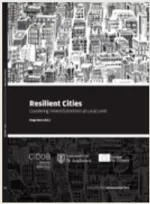Appendix. Resilient Cities

His structural integrity checklist was originally published in the handbook “Structural quality standards for work to intervene with and counter violent extremism” by the Ministry of the Interior, Digitisation and Migration of Baden-Württemberg (Koehler, 2017). This checklist was designed to help policymakers and practitioners assess existing PVE and deradicalisation programmes’ quality, to identify needs for improvement and to develop structurally sound intervention programmes from scratch. An in-depth discussion about each element and a grading scale can be found in the monograph “Understanding Deradicalization” (Koehler, 2016).
This checklist provides an evidence-based collection of structural integrity factors that need to be considered in the development of PVE and deradicalisation programmes, as well as in the assessment of existing programmes. This approach does not assess or measure the actual impact of a programme but creates the basis for maximising the chance of impact as based on a solid programme design. Based on the Correctional Programme Checklist (Latessa, 2013) this checklist can be either used to grade an existing programme’s structural quality (evaluative use – each item must be graded from “weak” to “strong” to achieve a cumulative numerical scale) or to systematically develop a new programme. The following version of the checklist mainly helps to design new programmes. Each of the 64 structural items was placed within one of six main structural quality fields, which should be filled with specific content during a programme’s development. It is not possible to define this content upfront, as each PVE programme must address various different contextual factors, such as, for example, political and social environment, stakeholders’ goals and interests, available funding, target group, and time frame. Practitioners and policymakers are advised to seek expert involvement (both from academics and experienced PVE practitioners) to systematically discuss each item, define qualitative terms (e.g., “sufficient”) and connect them to a detailed model of practical operation. It is crucial to choose the adequate PVE programme type according to goals, target group and envisioned approach (for an overview see: Koehler, 2016). After that, the checklist below guides programme developers through the key aspects of PVE programme design.
Structural elements
Running and developing a programme
• Senior management and project leaders are sufficiently trained
• Senior management and project leaders have practical experience
• Involvement in selection and training of staff
• Sufficient supervision of staff by superiors
• Senior managers have their own experience of the advisory activities
• Programme is structured on the basis of solid theory
• Thorough consultation of academic literature in the development phase
• Project in line with the current state of research
• Approach evaluated by external experts
• Inclusion of pilots
• Acceptance of the project among leading experts in the field
• Funding situation appropriate with regard to the aims
• Financial situation stable over the past two years Organisation
• Clearly defined objectives
• Reception, documentation and categorisation system in place for new cases
• Lowest possible threshold for initial contact
• Personal point of contact for the initial contact
• Interdisciplinary team of caseworkers
• Availability of psychological expertise
• Former extremists available as advisers
• Former extremists deployed under a framework of particular quality standards
• Integration of the victim perspective
• Perspective of the local authorities included
• Specific caseworker training at a sufficient level
• Selection of personnel according to expertise, practical experience and ethical values
• Regular team meetings and case discussions
• Supervision
• Assessing personnel according to quality of their casework
• Firm methodology for risk analysis and classification of security relevance
• Firm counter-extremism mechanism (identification of radicalising factors, corresponding selection of methods, impact assessment and documentation or recalibration)
Participant classification
• Target group clearly defined and appropriate to the programme aims
• Definition and consistent application of exclusion criteria
• Performance of risk analysis
• Defined risk levels using in-house procedures
• Assured staff application of risk analysis
• Mechanism for identifying radicalising factors anchored in staff training
• Treatment methods adjusted to individual radicalising factors
• Adequate case documentation system capturing relevant case evolution
• Case documentation system enables internal and external evaluation Care and advisory services
• Emphasis of services on individual radicalisation
• Methods for boosting cognitive capabilities applied
• Methods of general and vocational education
• Inclusion of place of residence
• Possibility of protective measures
• Intensity of treatment according to risk level
• Availability of handbook for personnel
• Caseworker-participant compatibility
• Compatibility of caseworkers and programme
• Possibility of participant feedback
• Adequate incentives for participation
• Adequate sanction mechanisms
• Negative impacts of treatment are recognised and documented
• Clear criteria for case closure
• Case closure is planned and prepared
• Follow-up
• Ratio of closed to uncompleted cases is measured
• Case monitoring post-closure
• Inclusion of affective circle of family and friends
Quality assurance
• Internal and external quality assurance in place
• Statistics on known examples of relapses
• Complete case evaluation prior to closure
• Regular external evaluations
• Critical and transparent discussion of failures
Transparency
• At the very least fulfilment of the Transparent Civil Society 10 Point
Initiative